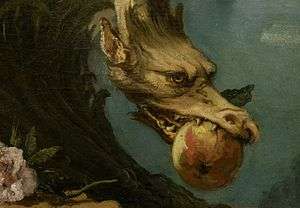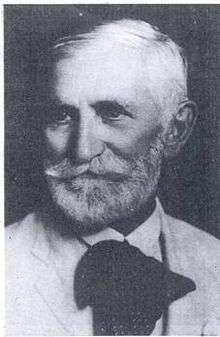Sárkány (mythology)

A dragon or sárkány is a legendary and mythical creature in the Hungarian folklore and mythology, which mostly appears in the form of a scaly, winged, reptilian beast, but in some cases it could be a mixture of other beings.
Early appearances
Before the 18th century, dragons were part of the ancient Hungarian belief system. According to their oldest, universal function, dragons originally symbolized the unity of the material and spiritual world, and they had a transcendental meaning as they had the role of being the transmitter between two realms.[1] Later, they got associated with natural phenomena, where were either the makers or the appeasers of the violent forces of nature. [2] It could be stated that in most cases, they were bringers of rainstorms and tornados, as the Hungarian people believed that the rumble of the thunder was the roaring of battling dragons above the clouds, which crashed the clouds with their tails in the heat of the fight, and in consequence, flood was pouring over the Hungarian fields.[3]
Characteristics
.jpg)
Though the Hungarian legendaries do not offer the sufficient information about the characteristics of the ancient dragons in the early Hungarian belief, in some regions it was an accepted fact that dragons were born through a transformational process of another being. For instance, around the region of Csallóköz, it was believed that dragons were created from either an old pike or a 7 or 13-year-old rooster. As the tales tell, when a pike is laying in the mud for several months, it changes into a dragon. In the rooster's case, a dragon is born when the bird is hiding around the house for too long; it becomes a dragon, who can be only lured out by the so-called Garabonciás, a human with magical qualities, who later uses the beast as a mount.[4] In other regions, the primary belief was that dragons can be born from other dragons as well, where the female, after being pregnant for 7 years, suckles its son for another 7 years.[5] As the ancient Hungarian belief tells, dragons usually appear in two forms: the first is the rideable, tyrant mount of the Garabonciás, and the other is the serpent-like creature with several fins, long claws and teeth. Their scales can vary between all the colours of the rainbow, and they are so strong that almost no weapon can hurt their underlying skin. Moreover, they usually live within hollow trunks, dens, or in the abandoned caves of the Hungarian mountains.
Role
Though in the early stories they had no treasure-hoarding characteristics, as the centuries passed, they became the collectors of gold and other gems. This dragon figure got more popular when the image of the dragon slithered onto the pages of children's literature of the 19th and early 20th centuries, where they usually appear as aggressive beasts of prey. In these tales, they are always presented as the villains, whose role is setting the story in motion. In addition to this, they abduct humans, especially young maidens, and disturb the peaceful village and its inhabitants. The role of the hero is simple: by defeating the creature, the hero does not only save the princess, but he also gains reputation and prestige. [6]
Dragons in children's literature


In the Hungarian children's literature, the image of the dragon appears very often. In the 19th and 20th centuries, the figure of the beast is portrayed through the villain-hero relationship. It is worth to mention that in these stories, dragons are usually antrophomorphic, aggressive beings, who have human-like characteristics: although they are the villains of the stories, they frequently sing and dance, and the beasts do not say no to wine either. This image can be found in stories of the most well-known Hungarian authors, such as Elek Benedek, Gyula Illyés, or Arnold Ipolyi. In the János Diák, the dragon "sniffles with its nose", or in the Hajnal ("Dawn"), it is mentioned that dragons live in "Dragonland", where the hero needs to travel in order to save the kidnapped maiden.[7] In Gyula Illyés's storybook, Hetvenhét Magyar Népmese, the talking and cunning dragons are usually killed by a young, courageous boy, who symbolically steps into adulthood as he kills the beast.[8] In most of these tales, dragons have more the one head –vary between 6, 9, 12, 24 -, which indicates that importance of numerology in the Hungarian belief system. As the twentieth century came closer, another dragon depiction has transpired in the postmodern Hungarian literature: the image of the violent beast transformed into an emotional and wise being. Ervin Lázár's Hétfejű Tündér introduces the readers a tale of a boy, whose sickness can only be cured by killing the seven-headed dragon, however, when the boy realizes what an outstanding and beautiful being the dragon is, he cannot perform the task.[9] Besides, perhaps the most well-known instance for the image of the "new Hungarian dragon" is Süsü, created by István Csukás, who was a prominent figure in many Hungarian children's life. Not only is he a sensitive character, but also an exceptional dragon among his own kind as he has only one head, which leads him to his outcast status. Csukás focused on the sensitive, emotional representation of the dragon, where the children effortlessly can identify with the magical beast.[10] From a psychological point of view, the delicate beast in the fairy tales helps the children facing their inner "monsters", where the dragon offers a solution, or a help for the bigger, scarier problems that the child has to face with in the foreseeable future. [11]
References
- ↑ Pál, Edit (2001). Szimbólumtár: Jelképek, motívumok témák az egyetemes és a magyar kultúrából (in Hungarian). Balassi Kiadó. ISBN 978-963-05-1288-6.
- ↑ Ortutay, Gyula (1977). Magyar Néprajzi Lexikon (in Hungarian). Budapest: Akadémiai Kiadó. ISBN 963-506-451-9.
- ↑ Pivárcsi, István (2008). Székelyföldi Legendárium (in Hungarian). Új Palatinus Könyvesház. ISBN 978-963-274-016-4.
- ↑ Csaplár, Benedek (1851). "Csallóközi, Különösen Dunaszerdahely - Táji Népszokások". Népismereti Adalékok (in Hungarian). 1. (2). Check date values in:
|access-date=(help); - ↑ Ortutay, Gyula (1977). Magyar Néprajzi Lexikon (in Hungarian). Akadémiai Kiadó. ISBN 978-963-05-1288-6.
- ↑ Propp, Vlagyimir (1977). A Mese Morfológiája (in Hungarian). Osiris Kiadó. ISBN 978-963-379-461-6.
- ↑ Elek, Benedek (1989). Magyar mese-és mondavilág I-III (in Hungarian). Budapest: Móra Ferenc Ifjúsági Könyvkiadó. ISBN 978-963-9320-27-7.
- ↑ Illyés, Gyula (1977). Hetvenhét Magyar Népmese (in Hungarian). Budapest: Móra Ferenc Könyvkiadó. ISBN 978-963-11-2916-8.
- ↑ Lázár, Ervin (1973). Hétfejű Tündér (in Hungarian). Budapest: Madách Könyvkiadó. ISBN 978-963-389-630-3.
- ↑ Csukás, István (1985). Süsü, a sárkány (in Hungarian). Budapest: RTV Minerva. ISBN 978-963-7911-95-8.
- ↑ Kádár, Annamária (2014). Mesepszichológia (in Hungarian). Budapest: Kulcslyuk Kiadó. ISBN 978-963-89419-6-1.